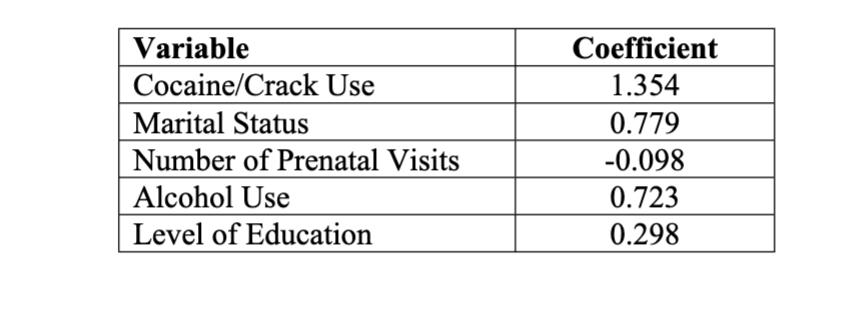In a study investigating maternal risk factors for congenital syphilis, syphilis is treated as a binary outcome variable, where 1 represents the presence of disease in a newborn and 0 represents absence of disease. The estimated coefficients from a logistic regression model containing the predictors cocaine or crack use, marital status, number of prenatal visits to a doctor, alcohol use and level of education are included in the table below. The estimated intercept is not included in the table. a. As an expectant mother’s number of prenatal visits to the doctor increases, does the probability that her child will be born with congenital syphilis increase or decrease? b. Marital status is a binary variable, where 1 indicates that a woman is unmarried and 0 indicates that she is married. What are the estimated relative odds that a newborn will suffer from syphilis for unmarried versus married mothers after holding the other variables in the model constant? c. Cocaine or crack use is also a binary variable. A value of 1 indicates that a woman used cocaine or crack during pregnancy, and 0 indicates that she did not. What is the estimated odds ratio that a child will be born with congenital syphilis for women who used cocaine or crack versus those who did not after adjusting for the other variables in the model? d. The estimated coefficient of cocaine or crack use has a standard error of 0.162. Construct a 95% confidence interval for the population odds ratio comparing women who used cocaine or crack versus those who did not. e. Conduct a test of the null hypothesis that the coefficient associated with cocaine or crack use is equal to 0.
In a study investigating maternal risk factors for congenital syphilis, syphilis is treated as a binary outcome variable, where 1 represents the presence of disease in a newborn and 0 represents absence of disease. The estimated coefficients from a logistic regression model containing the predictors cocaine or crack use, marital status, number of prenatal visits to
a doctor, alcohol use and level of education are included in the table below. The estimated intercept is not included in the table.
a. As an expectant mother’s number of prenatal visits to the doctor increases, does the probability that her child will be born with congenital syphilis increase or decrease?
b. Marital status is a binary variable, where 1 indicates that a woman is unmarried and 0 indicates that she is married. What are the estimated relative odds that a newborn will suffer from syphilis for unmarried versus married mothers after holding the other variables in the model constant?
c. Cocaine or crack use is also a binary variable. A value of 1 indicates that a
woman used cocaine or crack during pregnancy, and 0 indicates that she did not. What is the estimated odds ratio that a child will be born with congenital syphilis for women who used cocaine or crack versus those who did not after adjusting for the other variables in the model?
d. The estimated coefficient of cocaine or crack use has a standard error of 0.162. Construct a 95% confidence interval for the population odds ratio comparing women who used cocaine or crack versus those who did not.
e. Conduct a test of the null hypothesis that the coefficient associated with cocaine or crack use is equal to 0.

Trending now
This is a popular solution!
Step by step
Solved in 3 steps with 3 images


